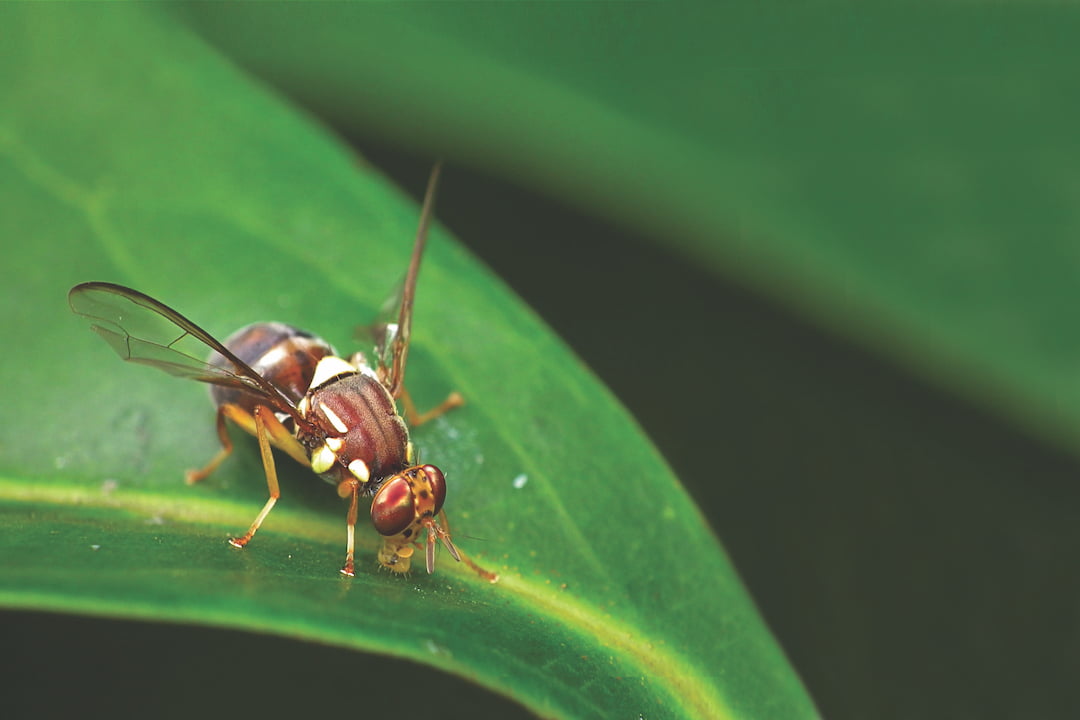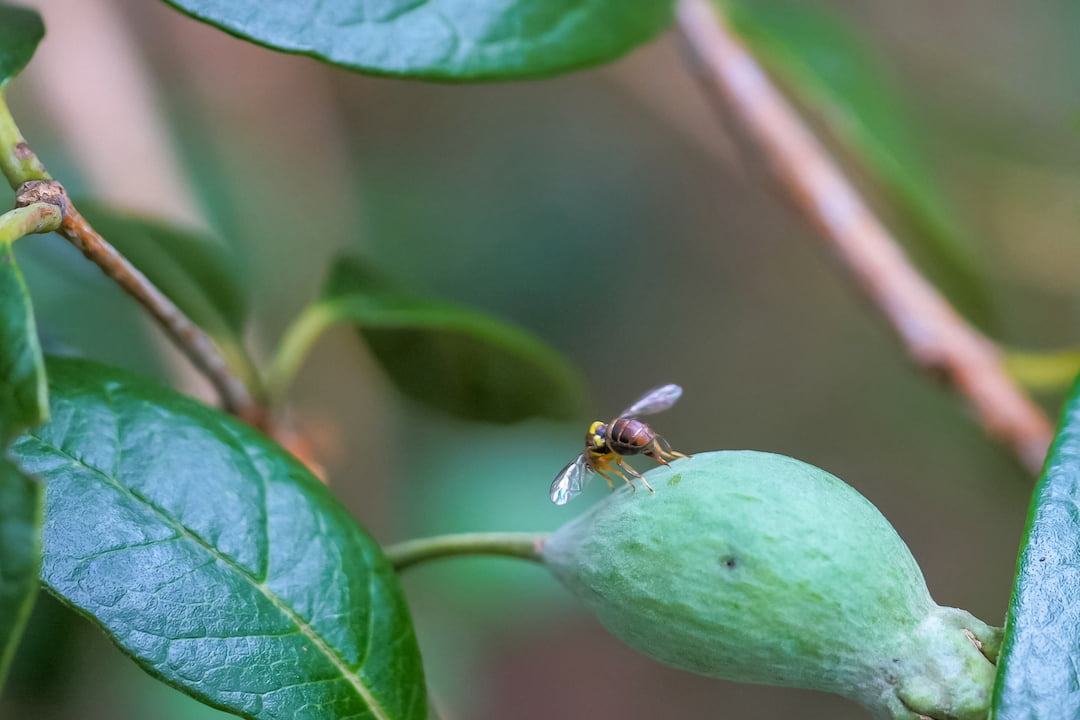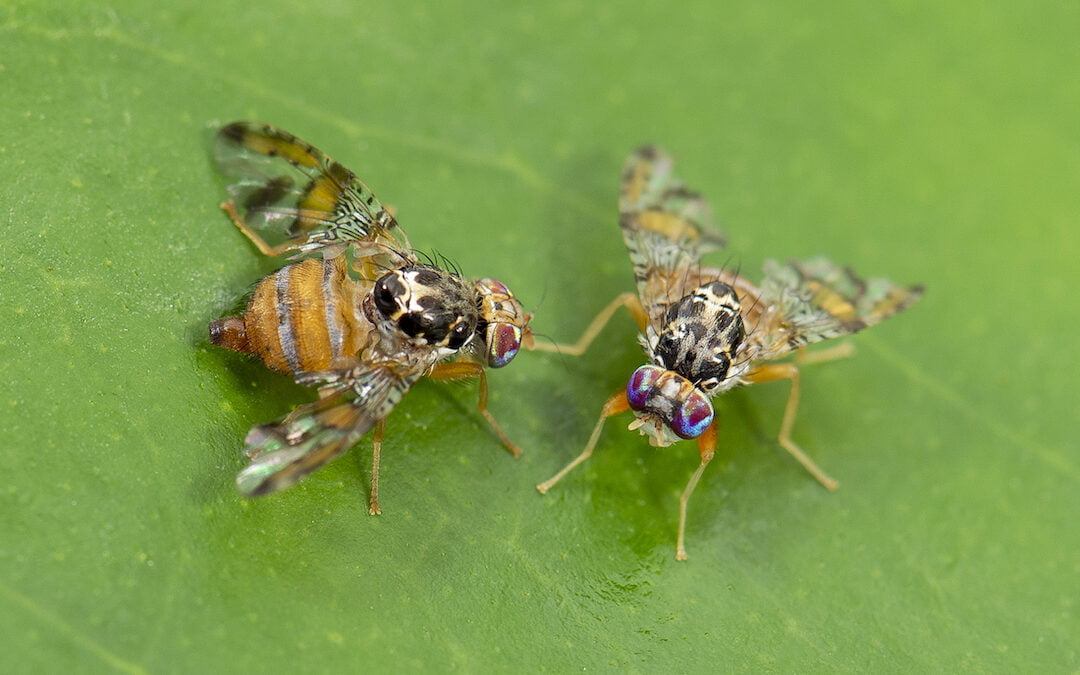Every year, fruit flies destroy hundreds of millions of dollars’ worth of fruit and vegetable in Australia.
But after three successive years of La Niña, the meteorological phenomenon that lowers temperatures and causes heavy rains, some parts of our country are facing the worst fruit fly infestation on record – and the potential for losses to escalate into the billions. We speak to three Australians on the frontlines of the war against one of the world’s most destructive agricultural pests.
Opening image by Pia Scanlon, DPRID WA.

The Queensland fruit fly.
The old timer
“Fruit flies are nothing new here in South Australia. We’ve never been free of them. But I’ve been a farmer for 30 years and last year was the worst I’ve ever seen. The climate has been perfect for them and they can breed more than they usually do and in places we have never seen them before,” says Mark Doecke, an orange farmer and chairman of Citrus South Australia.
Mark reckons 80% or more of the problem stems not from orchards like his but from fruit trees in residential areas. “In the summer, fruit flies will naturally go to people’s backyards where it’s cooler. And there’s nothing that they love more than stone fruit, so people can make a huge difference by maintaining their fruit trees. That means picking fruit off their trees as soon as they ripen and not leaving any rotten fruit on the ground. Or just getting rid of the trees altogether. In Waikerie, a town not far from where I live in the Riverina region, the government is running a program where they’ll take fruit trees out of your garden and replace them with gum trees – free of charge. It’s only been going since December but the uptake has been good. They’re already removed more than 100 trees.”
The Department of Primary Industries in South Australia is also trialling a more high-tech solution: Sterile Insect Technique, or SIT, where male fruit flies that have been sterilised with an X-ray are released by light aircraft over fruit growing areas. Female fruit flies can’t detect they are sterilised. They mate and nothing happens. Fruit fly populations are theoretically reduced.
“It’s the biggest and best tool in our box,” Mark says. “Unlike pesticides, SIT is non-invasive, you can put them everywhere and people don’t get upset. They’ve been releasing 20 million per week but with this many fruit flies, it’s not enough. By spring they’re hopefully going to double it to 40 million per week.”

A major agricultural pest, the queensland fruit fly, laying eggs in a ripe fruit.
The inventor
“We’re always facing pests and diseases that are seasonally dependent, but fruit flies have always been one of those things we find very difficult to control,” says Brendon Hoyle, an organic strawberry farmer in the Glass House Mountains of Southeast Queensland.
“With soft skin fruit like strawberries,” he says, “they lay the eggs under the skin and the eggs eat through the inside. A lot of time it is quite difficult to notice there’s a problem by just looking at the fruit from the outside, which makes it really hard for us to rely on the quality of our strawberries. Two years ago the infestation was so bad we had to stop growing in the middle of the season.”
Brendon says fighting fruit flies is getting harder as a result of the nationwide trend towards less invasive farming techniques: “The agricultural industry as a whole is starting to clean up its act and use softer chemicals. And while that is a good thing and much better for our health, with that we are losing the ability to control fruit flies. As an organically certified farmer, I can’t use any chemicals at all. So we have to come up with new kinds of defences. We are looking at options all the time.”
Brendon is currently using a combination of defences that include sticky traps, sterilised fruit flies and, believe it or not, a giant vacuum cleaner he invented that won him the title of Australian Organic 2022 Farmer of the Year.
“In 2015 I was in the US where they also have big problems with fruit flies and I saw a bug vacuum cleaner towed with a tractor over a crop,” he says. “I brought the idea back to my farm and designed a version of it for strawberries. When I realised it helped, I made a bigger version that covers three rows of strawberries at the same time and sits 10cm over the strawberry plants. It has big hydraulically driven fans on top that suck the bugs off the crop and push them through a screen, which effectively kills them.”

Mediterranean fruit fly or medfly (Ceratitis capitata) is considered to be one of the most destructive fruit pests in the world.
The chair
“I’ve spent a lifetime working in agriculture and exports and I can tell you as far as problems go, fruit flies are huge,” says John Webster, chairperson of the National Fruit Fly Council. “Look at this way: the horticulture industry employs 60,000 people in Australia and exports $3 billion worth of produce every year. Forty-three percent of that produce is susceptible to fruit flies, so if we were to let the problem get ahead of us, fruit flies could become a billion-dollar problem.”
The reason it so far hasn’t, John says, is all the fantastic work being done by the scientific community and customs officers who keep new fruit fly species out of Australia and make sure our exports are also fruit fly free: “We have a reciprocal obligation with the countries we export to, to make sure we don’t send them problems with our products. We don’t just whack it into a container and send it off. There’s a whole bunch of science-based protocols and very detailed negotiations to make sure our fruit and vegetables are safe for importing countries.”
John also credits the hard work authorities do to prevent fruit flies from travelling between states, especially out of Queensland, where 90 per cent of horticulture is susceptible to fruit flies. But he also believes everyday Australians can play a more active role to fight fruit flies.
“When you fly into Australia, it’s really clear how vigilant we all have to be because you get fumigated against fruit flies in the plane when it lands and there are these massive fines for bringing in certain kinds of foods,” John says. “But say you’re flying on Rex from Queensland to Mildura and you’re carrying a hitchhiker in your lunchbox you don’t know about. You then rent a car, cross the border to South Australia and inadvertently cause an outbreak.
“That’s why you have to be very careful not to carry any fruit and vegetables from one airport to another,” he says. “Don’t bring it to eat, not even at the airport before you take off. Leave it at home. It will make a huge difference. Every bit of effort will make a difference to our biosecurity. Every bit of effort counts.”
For more on biosecurity, read about how we’re keeping the varroa mite off our honeybees here.

